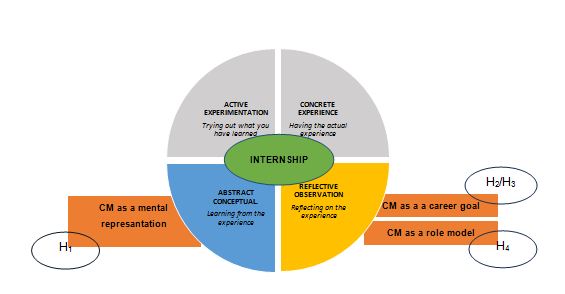The Influence of Construction Site Internships in Architecture Education
A Study on Kolb's Experiential Learning Theory
DOI:
https://doi.org/10.31522/p.31.2(66).12Keywords:
career development, construction site internship, construction site manager, experiential learning, Kolb, role modelAbstract
This study examines the impact of internships and the influence of construction site manager (CSM) as a role model on students' educational and career paths, employing Kolb's experiential learning theory as a theoretical framework. To address the research objectives, a questionnaire was conducted on 93 architecture students, focusing on four key research questions: (1) Does the internship experience affect students' perception of CSMs? (2) Does it influence their career goals related to CSM positions? (3) Does the internship experience alter the career aspirations of intern students regarding the career as a construction site manager? and (4) Do students perceive CSMs as role models after completing their internships? The findings show how internships significantly affect students, improving their comprehension of the CSM role, influencing their aspirations for their careers, and offering life-changing experiences. It is anticipated that these findings will significantly advance the field of architecture education and have applications in curriculum development, internship program design and execution, and career counseling services, especially in underdeveloped or developing countries.
References
ACE, (2023). Architectural Profession in Europe 2022 Report.
Aji, G. P. (2022). Students’ Reflection On The Experience In Online School Internship Program Based On Experientıal Learning. IJIET (International Journal of Indonesian Education and Teaching), 6(2), 204-225. https://doi.org/10.24071/ijiet.v6i2.4820
Bae, H., Polmear, M., & Simmons, D. R. (2020). The impact of internships on civil engineering students’ exploration of learning styles. In 2020 ASEE Virtual Annual Conference Content Access. https://doi.org/10.18260/1-2--35330
Bal, Hüseyin. (2001). Bilimsel Arastırma Yöntem Ve Teknikleri . Süleyman Demirel Üniversitesi Basımevi, SDÜYayın No:20:Isparta
Bandura, A. (1977). Social learning theory. Englewood Cliffs, NJ: Prentice-Hall.
Bell, A. P. (1970). Role modelship and interaction in adolescence and young adulthood. Developmental Psychology, 2, 123-128. https://doi.org/10.1037/h0028613
Bettinger, E. P., & Long, B. T. (2005). Do faculty serve as role models? The impact of instructor gender on female students. American Economic Review, 95(2), 152-157. https://doi.org/10.1257/000282805774670149
Biket, A. P., & Sevimli, G. (2023). Türkiye’de Mimarlik Eğitimi Ve Proje Yönetimi. Yakın Doğu Üniversitesi Yakın Mimarlık Dergisi, 7(2). https://doi.org/10.32955/neujna202372714
Birhan, A. T., & Merso, T. A. (2021). Supporting engineering education through internship mentoring program: approaches, perceptions and challenges. Journal of technical education and training, 13(1), 185-194. https://doi.org/10.30880/jtet.2021.13.01.020
Bullock, K., Gould, V., Hejmadi, M., & Lock, G. (2009). Work placement experience: Should I stay or should I go? Higher Education Research & Development, 28(5), 481–494. https://doi.org/10.1080/07294360903146833
Chen, C. T., & Chen, C. F. (2011). The influence of internship experiences on the behavioral intentions of college students in Taiwan. The Asia-Pacific Education Researcher, 20(1), 73-92.
Chen, C. T., Hu, J. L., Wang, C. C., & Chen, C. F. (2011). A study of the effects of internship experiences on the behavioural intentions of college students majoring in leisure management in Taiwan. Journal of Hospitality, Leisure, Sport and Tourism Education, 10(2), 61–73. https://doi.org/10.3794/johlste.102.294
Çivici, F. (2021). İnşaat mühendislerinin kariyer planlamaları üzerine bir araştırma. Balıkesir Üniversitesi Fen Bilimleri Enstitüsü Dergisi, 23(2), 808-818. https://doi.org/10.25092/baunfbed.858666
Cord, B., & Clements, M. (2010). Pathway for student self-development: A learning orientated internship approach. Australian Journal of Adult Learning, 50(2), 287-307.
Davies, L. (1990). Experience-based Learning within the Curriculum. A synthesis study, Sheffield: Athenaeum Press.
Erşen, A. E. (2018). Mimarlik ve Tasarim Eğitimi Üzerine. Ejovoc (Electronic Journal of Vocational Colleges), 8(2), 64-72.
France, J., Milovanovic, J., Shealy, T., & Godwin, A. (2022). Engineering students’ agency beliefs and career goals to engage in sustainable development: differences between first-year students and seniors. International Journal of Sustainability in Higher Education. https://doi.org/10.1108/IJSHE-04-2021-0161
Fulani, O., Pase, O., Omeiza, A., Daniels, J., Alagbe, O., Aderonmu, P., & Udiminue, J. (2017). Gender and career aspirations of architecture students. In INTED2017 Proceedings (pp. 5437-5442). IATED. https://doi.org/10.21125/inted.2017.1266
Gamboa, V., Paixao, M. P., Da Silva, J. T., & Taveira, M. D. C. (2021). Career goals and internship quality among VET students. Journal of Career Development, 48(6), 910-925. https://doi.org/10.1177/0894845320902269
George, D., & Mallery, P. (2010). SPSS for Windows step by step : A simple guide and reference, 17.0 update. Allyn & Bacon.
Gómez, J., Tayebi, A., & Delgado, C. (2021). Factors that influence career choice in engineering students in spain: A gender perspective. IEEE Transactions on Education, 65(1), 81-92. https://doi.org/10.1109/TE.2021.3093655
Gül, Y. E. (2022). Metaphorical perceptions of teacher candidates regarding cultural diversity: a cross-cultural comparison. Universidad y Sociedad, 14(2), 570-578.
Gündeş, S., & Atakul, N. (2017). Internship Practices in Architectural Education: Student Perspectives. Megaron, 12(3). https://doi.org/10.5505/megaron.2017.86094
Inkster, Robert P., and Roseanna G. Ross (1995). The Internship as a Partnership: A Handbook for Campus-based Coordinators and Advisors. National Society for Experiential Education, Raleigh, North Carolina.
İlerisoy, Z. Y., & Aycı, H. (2019). Mimarlık son sınıf öğrencilerinin alan seçimlerine yönelik bir değerlendirme. Eğitim ve Toplum Araştırmaları Dergisi, 6(2), 192-214.
Irina, T. (2017). Career guidance for the stable professional development of architects. WIT Transactions on Ecology and the Environment, 226, 713-721. https://doi.org/10.2495/SDP170621
Jerez Gomez, M.P.; Bojica, A.; Martínez-del-Río, J. & Karaja, R. (2023) “Designing successful internships: exploring the role of duration, formalization and motivational practices”. Education+ Training, 65(3), pp. 433-453. https://doi.org/10.1108/ET-12-2021-0480
Jowdy, E., McDonald, M., & Spence, K. (2004). An integral approach to sport management internships. European Sport Management Quarterly, 4(4), 215-233. https://doi.org/10.1080/16184740408737478
Katz, D., & Kahn, R. L. (1978). The social psychology of organizations. New York: Wiley.
Kohlberg, L. (1963). Moral development and identification. In H. W. Stevenson (Ed.), Child psychology: The sixty-second yearbook of the National Society for the Study of Education (Part 1) (pp. 277-332). Chicago, IL: University of Chicago Press. https://doi.org/10.1037/13101-008
Kolb, D. A. (1984). Experiential learning: Experience as the source of learning and development. Prentice Hall.
Kolb, A. Y., & Kolb, D. A. (2005). Learning styles and learning spaces: Enhancing experiential learning in higher education. Academy of Management Learning & Education, 4(2), 193–212. https://doi.org/10.5465/amle.2005.17268566
Maertz P. Jr, C., A. Stoeberl, P., & Marks, J. (2014). Building successful internships: lessons from the research for interns, schools, and employers. Career Development International, 19(1), 123-142. https://doi.org/10.1108/CDI-03-2013-0025
Mihail, D. M. (2006). Internships at Greek universities: an exploratory study. Journal of Workplace Learning, 18(1), 28-41. https://doi.org/10.1108/13665620610641292
Miles, M. B., & Huberman, A. M. (2002). The qualitative researcher’s companion. Sage. https://doi.org/10.4135/9781412986274
Miller, N. E., & Dollard, J. (1941). Social learning and imitation. New Haven, CT: Yale University Press.
Mishkin, H., Wangrowicz, N., Dori, D., & Dori, Y. J. (2016). Career choice of undergraduate engineering students. Procedia-social and behavioral sciences, 228, 222-228. https://doi.org/10.1016/j.sbspro.2016.07.033
Mugenda, O. M.& Mugenda, A. G. (2003). Research Methods: Quantitative and Qualitative Approaches. Nairobi: ACTS Press.
Olanrewaju, O. S., & Ogunmakinde, O. E. (2021). Career Choice and Professional Preference of Architecture Students in Nigeria. 44th, 492.
Rask, K. N., & Bailey, E. M. (2002). Are faculty role models? Evidence from major choice in an undergraduate institution. The Journal of Economic Education, 33(2), 99-124. https://doi.org/10.1080/00220480209596461
Roever, C. (2000). Mead corporation’s creative approach to internships: success in a unionizedmanufacturing plant. Business Communication Quarterly, 63, 90-100. https://doi.org/10.1177/108056990006300110
Sapp, D. A., & Zhang, Q. (2009). Trends in industry supervisors’ feedback on business communication internships. Business Communication Quarterly, 72(3), 274-288. https://doi.org/10.1177/1080569909336450
Şekerci, Y.; Kahraman, M.U. & Çakmak, A. (2021) “Internship experience in architecture and interior architecture departments from students’ point of views”. Online Journal of Art and Design, 9(2), pp. 172-188.
Silva, C. S. C. D., & Teixeira, M. A. P. (2013). Internship experiences: contributions to the school-to-work transition. Paidéia (Ribeirão Preto), 23, 103-112. https://doi.org/10.1590/1982-43272354201312
Simons, L., Fehr, L., Blank, N., Connell, H., Georganas, D., Fernandez, D., & Peterson, V. (2012). Lessons Learned from Experiential Learning: What Do Students Learn from a Practicum/Internship?. International Journal of Teaching and Learning in Higher Education, 24(3), 325-334.
Stirling, A., Kerr, G., MacPherson, E., Banwell, J., Bandealy, A., & Battaglia, A. (2017). Do Postsecondary Internships Address the Four Learning Modes of Experiential Learning Theory? An Exploration through Document Analysis. Canadian Journal of Higher Education, 47(1), 27-48. https://doi.org/10.47678/cjhe.v47i1.186196
Şekerci, Y., Kahraman, M. U., & Çakmak, A. (2021). Internship experience in architecture and interior architecture departments from students’ point of views. Online Journal of Art and Design, 9(2), 172-188.
Taşçı, G. (2022). Metaphorical Perceptions of Academicians in Administrative Positions in Higher Education Regarding the Concept of Sustainability. International Journal of Curriculum and Instruction, 14(1), 138-154.
Tener, R., Winstead, M., & Smaglik, E. (2001). Experiential learning from internships in construction engineering. 2001 Annual Conference (pp. 6-486).
Tezcan, M. (2013). Sosyolojik kuramlarda eğitim. Ankara: Anı Yayıncılık.
Turkish Ministry of Environment, Urban Planning, and Climate Change, (2019). Regulation on Construction Site Managers.
Wallace, R. A., & Wolf, A. (2004). Çağdaş sosyoloji kuramları. Çev. Leyla Elburuz & Rami Ayas. İzmir: Punto Yay.
Wood, R., & Bandura, A. (1989). Social cognitive theory of organizational management. Academy of Management Review, 14, 361-384. https://doi.org/10.2307/258173
Yates, J. K. (2001). Retention of nontraditional engineering and construction professionals. Journal of Management in Engineering, 17(1), 41-48. https://doi.org/10.1061/(ASCE)0742-597X(2001)17:1(41)
Yıldırım, A., & Şimşek, H. (2016). Sosyal bilimlerde nitel arastirma yöntemleri. Seckin.
Zehr, S. M., & Korte, R. (2020). Student internship experiences: learning about the workplace. Education+ Training, 62(3), 311-324. https://doi.org/10.1108/ET-11-2018-0236

Downloads
Published
How to Cite
Issue
Section
License
Copyright (c) 2023 İkbal Erbaş

This work is licensed under a Creative Commons Attribution 4.0 International License.
Copyright (c) 2021 authors and journal.
This work is licensed under a Creative Commons Attribution 4.0 International License.
Authors who publish with this journal agree to the following terms:
In agreeing this form, you certify that:
- You read the ethical codex of the PROSTOR available at journal web.
- You submitted work is your original work, and has not previously been published and does not include any form of plagiarism.
- You own copyright in the submitted work, and are therefore permitted to assign the licence to publish to PROSTOR.
- Your submitted work contains no violation of any existing copyright or other third party right or any material of an obscene, libellous or otherwise unlawful nature.
- You have obtained permission for and acknowledged the source of any illustrations, diagrams or other material included in the work of which you are not the copyright owner.
- You have taken due care to ensure the accuracy of the work, and that, to the best of your knowledge, there are no false statements made within it.
- All co-authors of this submitted work are aware of, and in agreement with, the terms of this licence and that the submitted manuscript has been approved by these authors.






